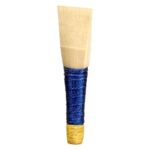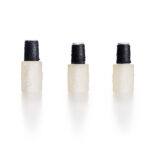
AS FEATURED IN

All 3 Models of the Amazing Infinity Bagpipe Chanter
by Jori Chisholm, Founder of BagpipeLessons.com
Last Updated: May 7, 2024
- Blackwood Model: Combines traditional craftsmanship with modern design, offering a rich tone and balanced sound across all notes.
- Polypenco Model: Made from durable synthetic material, it provides a consistent, bright tone, perfect for different climates and favored by pipe bands for its affordability.
- B Flat Model: Ideal for playing with orchestral instruments, this model tunes precisely to B Flat, allowing for seamless ensemble performances.
Watch the video and scroll down to read the full video transcript.
Video Transcript: Today we’ll take a close look at the incredible Infinity Pipe Chanter, crafted by the world famous bagpipe maker R.G. Hardie & Co. in Scotland. If you’ve been keeping up with BagpipeLessons.com and my YouTube channel, you’ve heard how much I LOVE this chanter. But did you know there are three different models of the Infinity chanter? In today’s video, I’ll give you an up-close look at each model and share why the Infinity Chanter is my favorite chanter, and a favorite of pipers around the world, from beginners to world champions, and for both soloists and pipe bands. And I’ll tell you about a new exclusive discount I have for you to get your Infinity chanter AND my popular and award-winning Tone Protector Digital Chanter Cap. Stick around, you don’t want to miss this!
About 25 years ago, bagpipe makers started making chanters with bigger holes because they thought bigger holes would make a louder sound. However, these larger holes make it difficult for pipers to play cleanly and precisely. With bigger holes, it’s easy to accidentally not cover a hole completely, which makes it harder to play clean and can be the cause of squeals and chirps. Imagine trying to cover the largest hole with your smallest finger—that’s tough, especially in cold weather when your fingers aren’t as nimble.
I noticed that some pipers who played well indoors or on warm days often struggled when it was cold. To help cover these large holes more easily, I resorted to putting tape on the bottom of the holes to make them easier to cover. But using too much tape could cause other problems like loud piercing squeals at random times. I talked to other pipers, and many missed the older chanters that had smaller holes. These older chanters were easier to play, but they didn’t sound as good with modern reeds.
The newer chanters sounded great, but the big holes made them hard to play. I wanted a chanter that sounded bright and stayed in tune but also had smaller, closer holes for easier playing. I asked some bagpipe makers if they could make a chanter like this for me. They said it was impossible to make a chanter with smaller holes and a bright and projecting modern sound.
Then, a few years later, I got a message from Alastair Dunn from R.G. Hardie & Co. who told me he had been working on a new chanter with smaller holes and sent me one to try. When I tried it, I loved how the smaller holes felt under my fingers, and the spacing was just right. And the sound was incredible.
This new chanter, called the ‘Infinity,’ proved that you could have a chanter that has a modern, top-notch sound and is easy to play. It has small holes that are closer together, which makes it comfortable to play and keeps the sound clear and bright. This was a big step forward in making chanters better for everyone.
Today the Infinity chanter is available in three models, and I have them all at the BagpipeLessons.com Shop bagpipelessons.com/infinity Let’s take a look at all three models one by one.
The Blackwood Infinity Chanter is the top of the line. It comes with a carrying case that shows off a beautifully made chanter. The wood grain is eye-catching—deep and detailed, showing off the high-quality Blackwood. I always like to take pictures of this beautiful wood grain when I get a new Blackwood chanter because, over time, as you play it, the wood darkens to a deep, dark brown or rich black color.
Holding the Blackwood Infinity Chanter for the first time, I noticed how comfortable it was. This comes from three main things: smaller hole sizes, closer hole spacing, and a special touch from R.G. Hardie —they’ve smoothed out the edges of the holes. This innovative design makes it feel like an old friend that’s ready to play, right from the start.
The Blackwood Infinity Chanter has a bright and clear sound that is consistent across all the notes. When pipers talk about a chanter being balanced, they usually mean two things: the pitch should be just right from the lower to the higher notes meaning the top hand notes aren’t too sharp or flat, AND the volume should be evenly loud across all notes so it’s not overly loud on the bottom hand and thin and quiet on the top hand. This chanter does both of these incredibly well, giving you a balanced overall sound that is warm and clear.
This chanter is also very “easy to reed,” which means it works well with many different types of reeds. Some chanters are finicky and only sound good with certain reeds, but not this one. Just find a good reed, put it in, and you’re ready to play. This makes it a favorite choice for solo players because it’s easy to use and sounds great.
Many pipers tell me this chanter is their favorite chanter that they’ve ever played: how it sounds and how it feels to play. The thoughtful design of the smaller holes, with the smooth rounded edges, and the closer hole spacing combined with an incredible sound that’s easy to get with all makes of reeds makes the Blackwood Infinity chanter the top choice for pipers who appreciate the very best.
The Polypenco Infinity Chanter comes in a clear tube. It’s made from a tough synthetic plastic known as polypenco, which is also called delrin or acetal. This material is great because it stands up well to wear and it’s stable in different playing conditions.
Like the more expensive Blackwood version, this chanter has smaller holes and they are placed closer together compared to many other pipe chanters on the market. This design helps you play your faster, more difficult tunes with greater clarity and precision of fingering. However, the edges of the holes in the Polypenco chanter are not smoothed out. Some players actually prefer this crisp feel on the chanter.
The sound of the Polypenco Infinity Chanter is similar to the Blackwood model but the polypenco material tends to reflect the sound slightly more than Blackwood, giving it a brighter tone. The Blackwood chanter typically has a slightly mellower sound. Despite this difference, it shares many of the same excellent qualities as the Blackwood chanter. It’s easy to reed, meaning it works well with a variety of reed types very little fuss. It also has a very balanced sound across all notes, both in volume and pitch, ensuring that every note is clear and tuning is easy.
An additional advantage of the Polypenco chanter is its affordability compared to the Blackwood model. This makes it a particularly attractive option for pipe bands. More and more bands around the world, competing at all levels, are choosing the Infinity chanter. This is not surprising given its combination of a fantastic, bright sound and the stability that simplifies tuning and helps pipes stay in tune, all at a great value.
The Polypenco Infinity Chanter offers the benefits of the premium Blackwood model with the added toughness and resilience of the poly material and at a lower cost, making it the top choice for pipers and pipe bands seeking quality performance without breaking the budget.
There’s a third model of the Infinity Chanter, also made from polypenco, but it’s special because it’s tuned to B Flat. Let me explain: Normally, bagpipes have a lot of pitch variability, which means the exact pitch can change depending on different factors like the weather or how long you’ve been playing. When playing on your own, you tune your drones to match each other and the low A on your pipe chanter. Then, you adjust the tuning of other notes relative to that low A pitch. On one day, your low A might be at 480 Hz, and if it’s warmer the next day, it could rise to 482 Hz. Normally, this isn’t a big deal. This is what we expect from bagpipes.
Thanks to modern innovations like moisture control systems and my award-winning Tone Protector Digital Chanter Cap with Two-Way Humidity Control, pitch stability has improved significantly but even the best bagpipes will vary slightly in pitch from day to day. Most pipers aren’t too concerned with the exact pitch of their pipes (within reason) as long as the pipes are tuned to themselves. I have some great videos on the BagpipeLessons.com YouTube Channel about how to tune your pipes using my popular InTune Mic which connects wirelessly to your mobile device and let’s you harness the power of incredible tuning apps like the Braw Bagpipe Tuner.
In a pipe band situation, the pipe major or whoever is tuning the band will determine the band’s pitch and then go about tuning everyone’s drones and chanters. Again, the pitch varies but these days, most modern bagpipes are going to be a Low A pitch somewhere in the range of the mid 470s to upper 480s or even higher if it’s a really hot day. That’s a big range.
But, if you are planning to play with other instruments like piano, guitar, violin, bass, brass instruments, or pipe organ you will need to be careful about tuning your pipes. These other instruments use standard tuning with a fixed pitch, which means they almost always tune their instrument to an exact pitch, typically A is 440 Hz. If you take your tuner and play A on a well-tuned piano it is going to show 440 Hz. If you go up to the next key, B Flat, it will show 466.1 Hz. If you go up to the next note, B, the tuner will show 493.8 Hz. So our most important note, Low A, which is the same note as your drones is somewhere higher than B flat and lower than B on an instrument with standard tuning, like piano or guitar or organ.
If you are playing with those other musicians with your pipes with Low A in the 470s or 480s it is going to sound really, really bad. The challenge of playing with other musicians with the typical modern bagpipe set up is really two things: the pitch is too high and it doesn’t match a specific note. It’s in between notes for other musicians. This is a problem, for example, a piano player can play A or B flat or B , but there are no notes in between.
So to play in tune with other musicians, we need to get our pipes tuned to a specific fixed pitch. It’s difficult or impossible to do it with your current set up just with tuning or reeds or tape; modern pipe chanters aren’t designed to play at such a different and lower pitch. You need some help from your equipment, and here’s where the Polypenco Infinity B Flat chanter comes in. It has all of the qualities and benefits of the standard Poly Infinity Chanter but the holes are positioned lower on the chanter to achieve a lower pitch. And more precisely, it’s designed so the Low A is tuned to 466 Hz which is the exact pitch of B flat on other instruments.
Hold on: you might be thinking: Why are we tuning our Low A to B Flat? Why not just tune the Low A on our pipes to A, 440 Hz. You can do this but the difference between the pitch of the modern bagpipe in the 470s or 480s and 440 Hz is a big gap in terms of pitch. It’s much easier to get down to 466 Hz which is the pitch of B flat. And that’s exactly what the Poly Infinity B Flat Pipe Chanter does.
Tuning to B Flat is a great way to blend the pipes with other instruments. If you’ve heard recordings of regimental bands like the Coldstream Guards Band and Pipes and Drums of the Royal Scots Dragoon Guards -— they are playing in B flat. Have you heard ACDC’s Long Way to the Top If you Want to Rock and Roll? This is probably the most famous rock and roll song to feature bagpipes—and the bagpipes are tuned to B flat. One of my all-time favorite piping recordings is a Bagpipe & Organ Recital with piper William Boyle. I love the tunes and the playing on this recording and guess what, the pipes are tuned to B flat. Check out all of these recordings, I’ll put some links in the description below.
So that’s where the Polypenco B Flat chanter comes in. It has all of the same features that pipers love about the Blackwood and Poly Infinity chanters but it’s designed to play at a lower pitch than the other Infinity chanters, so you can play with other fixed pitch instruments. How do they do it? The holes are positioned lower and in the precise spot you need to get perfect tuning at the perfect, lower pitch.
You don’t need a special reed for the B Flat Infinity Chanter—it’s designed to work well with any high-quality pipe chanter reed. However, my personal recommendation is the Foundation Reed, exclusively available at my BagpipeLessons.com Shop. This reed is the result of my collaboration with one of the world’s leading reed makers and is crafted to my exact specifications. It embodies everything I look for in a reed.
 Each reed is stored in a humidity-controlled environment from the moment it is made, during transportation, and through to testing, ensuring consistent quality. I personally select each reed, so you can be assured of its performance. You can order these reeds in the strength that suits your playing style, and they’re guaranteed to meet or exceed your expectations. You can order exactly the number of reeds you need, eliminating the common problem of buying in bulk and only finding a few that suit your needs.
Each reed is stored in a humidity-controlled environment from the moment it is made, during transportation, and through to testing, ensuring consistent quality. I personally select each reed, so you can be assured of its performance. You can order these reeds in the strength that suits your playing style, and they’re guaranteed to meet or exceed your expectations. You can order exactly the number of reeds you need, eliminating the common problem of buying in bulk and only finding a few that suit your needs.
You can pick the exact strength of Foundation reed that you need and order yours today at bagpipelessons.com/foundation
But what about the drones? You’ll also need to get your drones tuned to the lower pitch too. When tuning the drones, we can lengthen them by raising the drone tops to lower the pitch. But you probably don’t have enough length on the drones to get them all the way to B Flat 466, so you a need quick, simple, and easy way to get that extra length—and ideally you want to keep the position of the drones tuning at the optimal spot and you want to use your existing drone reeds they way are and not have to adjust the tuning screws or bridles. Well, I got you covered!
The Drone Reed Extenders from R.G. Hardie are the perfect solution to match your existing drones and drone reeds to play in B Flat.  You can keep your existing drone reeds. Instead of lengthening the drones or messing with the reeds themselves, simply attach the drone reed extender to the bottom of your reed and then reinsert it into the drone. This extra length is all you need to get your regular drone setup down to the lower pitch to match B Flat. These extenders are straightforward to use, durable, and precisely designed. I have them at the BagpipeLessons.com Shop and there’s a link to it below and also on the Infinity chanter page. So if you are considering the Poly Infinity B Flat chanter make sure to get a set of these drone reed extenders, too. They make it super easy to switch from your regular set up to B flat. Just swap out your chanter from the B flat chanter and pop the extenders on to your drone reeds and you are in action in just minutes.
You can keep your existing drone reeds. Instead of lengthening the drones or messing with the reeds themselves, simply attach the drone reed extender to the bottom of your reed and then reinsert it into the drone. This extra length is all you need to get your regular drone setup down to the lower pitch to match B Flat. These extenders are straightforward to use, durable, and precisely designed. I have them at the BagpipeLessons.com Shop and there’s a link to it below and also on the Infinity chanter page. So if you are considering the Poly Infinity B Flat chanter make sure to get a set of these drone reed extenders, too. They make it super easy to switch from your regular set up to B flat. Just swap out your chanter from the B flat chanter and pop the extenders on to your drone reeds and you are in action in just minutes.
 When you purchase any of the Infinity chanters from my BagpipeLessons.com Shop, you now have the exclusive opportunity to add my award-winning Tone Protector Digital Chanter Cap at a special discounted price. The Tone Protector is one of the piping world’s most popular products and a game-changer for pipers aiming for pitch stability and sound quality. It features a two-way humidity control system that maintains the ideal humidity level for your reed, ensuring consistent performance and extending the life of the reed. If you are getting a new Infinity chanter, you definitely want to protect your reed with the Tone Protector Chanter Cap. If you want to protect all of your reeds, make sure to get the Tone Protector Reed Case, too.
When you purchase any of the Infinity chanters from my BagpipeLessons.com Shop, you now have the exclusive opportunity to add my award-winning Tone Protector Digital Chanter Cap at a special discounted price. The Tone Protector is one of the piping world’s most popular products and a game-changer for pipers aiming for pitch stability and sound quality. It features a two-way humidity control system that maintains the ideal humidity level for your reed, ensuring consistent performance and extending the life of the reed. If you are getting a new Infinity chanter, you definitely want to protect your reed with the Tone Protector Chanter Cap. If you want to protect all of your reeds, make sure to get the Tone Protector Reed Case, too.
The Infinity Chanter is a huge deal in the bagpipe world because of its innovative design, great sound, and how comfortable it is to play. It’s perfect for pipers at any level, whether you’re just starting out or you’ve been playing for years. It’s popular with soloists and pipe bands. And for playing with other musicians, the B flat model is the best option.
You can learn more about the Infinity chanter and get one for yourself today at the BagpipeLessons.com Shop at https://bagpipelessons.com/infinity and see more photos, videos, and details.
If you have any questions, feel free to drop them in the comments section below.
If you are looking to take your piping to the next level, please check out my BagpipeLessons.com Inner Circle. With your membership, you gain full access to the very best at BagpipeLessons.com. This includes weekly live interactive online classes for pipers for all skill levels led by me and World Champion guest instructors. You’ll also get access to my exclusive lesson library filled with hundreds of videos, lessons, tunes, exercises, demonstrations, and more covering EVERY topic in piping from music theory to technique to tuning maintenance set up and so much more. And you get personalized support from me to help you reach your piping goals. To find out more about joining my Inner Circle, please visit https://bagpipelessons.com/membership
For additional free resources, including videos, lessons, and guides, make sure to head over to BagpipeLessons.com/learn. And download my free pdf guide called “How to Achieve a World-Class Bagpipe Sound,” — the link is in the description below.
And please check out some of the other videos I have here on the BagpipeLessons.com YouTube Channel. And Remember to subscribe and click the notification bell to stay updated when we post new videos. When you subscribe, it lets YouTube know that you like my videos and it helps me grow the Channel by recommending my videos to other pipers who might find them useful, too.
Thank You and Happy Piping!







